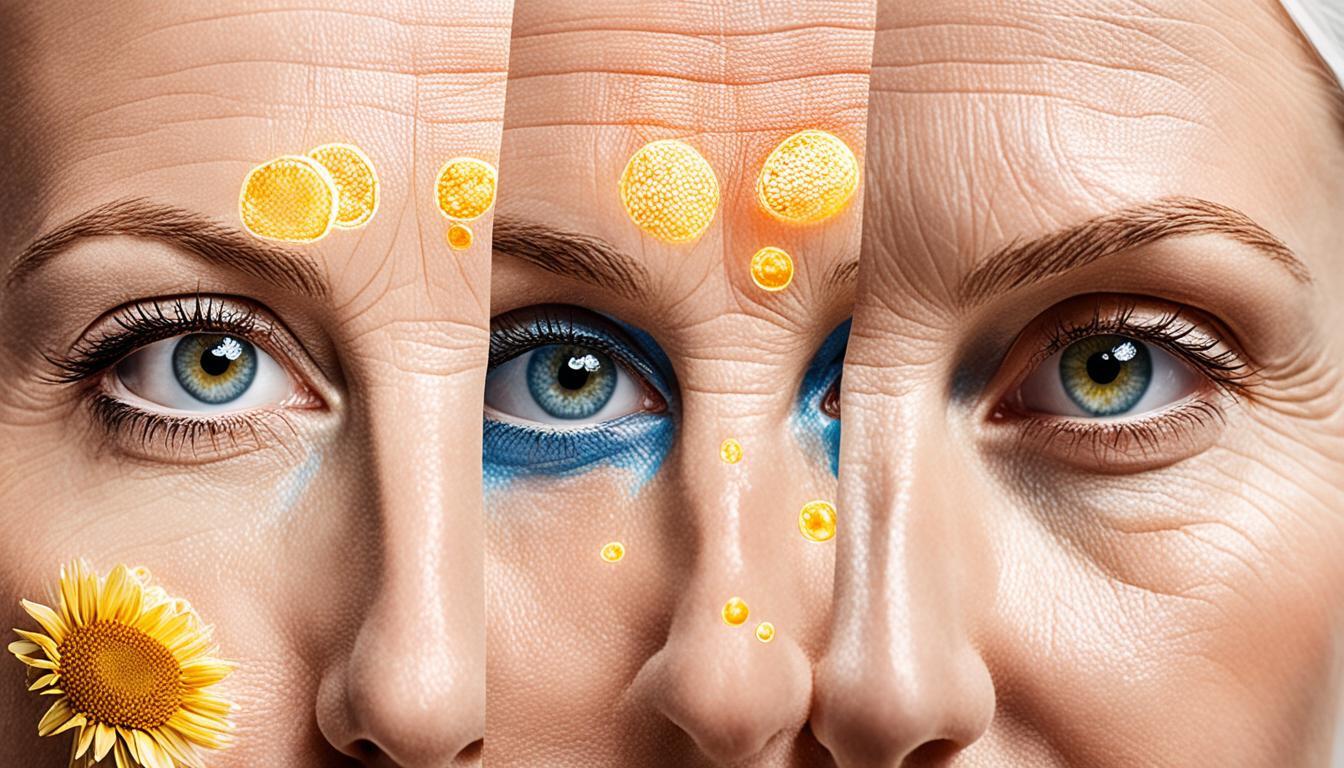Solar lentigines, or lentigo solaris, are dark patches on sun-exposed skin. They often show up on elderly people’s skin. These patches happen because the skin makes more melanin. The reason behind this isn’t totally clear. However, it’s likely due to genes, sun, and getting older.
These dark, flat spots are usually round or oval. They vary in size, from a few millimeters to several centimeters. Doctors spot lentigines solar by looking at the skin and asking about sun exposure.
People with this condition have a few ways to treat it. They can use creams, get cryotherapy or laser therapy, or get chemical peels. Stem cell therapy is a new option for making the skin look better. Stem cells can change into different cell types. They’re known to help with skin tone, texture, and how elastic the skin is. But we need more studies to be sure about stem cell therapy for lentigines solar and other skin problems.
Key Takeaways:
- Lentigines solar, or solar lentigines, are hyperpigmented patches that occur on sun-exposed skin, commonly in older individuals.
- The exact cause of lentigines solar is not fully understood, but it is believed to be a combination of genetic factors, sun exposure, and aging.
- Diagnosis of lentigines solar is typically based on the appearance of the skin lesions and the patient’s history of sun exposure.
- Treatment options for lentigines solar include topical creams, cryotherapy, laser therapy, chemical peels, and stem cell therapy.
- Stem cell therapy has shown promise in improving skin tone, texture, and elasticity, but more research is needed to fully understand its potential benefits and risks.
Note: The image related to the current content section has been inserted in the center of the text.
Causes and Risk Factors of Lentigines Solar Disease
Lentigines solar, or lentigo solaris, are dark patches on sun-exposed skin, often seen in older people. The main reason for them is too much sun, specifically the UV rays. This causes the skin to make more melanin, leading to these dark spots.
Getting older and your genes also influence getting lentigines solar. With time, skin can’t handle sun as well, so the risk goes up. If you have light skin or eyes, or your family has a history of this skin issue, you might get it too.
How you live your life matters too. If you spend lots of time outside without protecting your skin, you might see these spots. Also, if you often get sunburned, watch out for lentigines.
Even some medicines can up your chances of having lentigines solar. Hormone therapy and certain antibiotics are linked to more skin discoloration.
But remember, lentigines solar is not cancerous. It’s just a skin change.
Summary of Causes and Risk Factors
| Causes | Risk Factors |
|---|---|
| Prolonged exposure to UV radiation from the sun | Fair skin |
| Aging | Light-colored eyes |
| Genetic predisposition | Family history of lentigines solar |
| Significant time spent outdoors without sun protection | |
| History of sunburns | |
| Use of certain medications (hormone replacement therapy, antibiotics) |
Knowing what causes lentigines solar can help you avoid it. Wear protective clothes, use sunscreen, and stay in the shade when it’s sunny.
Diagnosis and Potential Stem Cell Therapy for Lentigines Solar Disease
Diagnosing lentigines solar disease starts with a close look at the skin by a dermatologist. They check the spots and ask about the patient’s sun history. Sometimes, they need to do a skin biopsy to be sure. This means taking a small skin piece to look at under a microscope.
Stem cell therapy is getting a lot of interest as a way to treat lentigines solar disease. Stem cells by themselves can become any other cell, so they’re great for fixing damaged tissue. You can get these cells from the patient’s own body or as donations. Early signs show that this therapy might help improve the skin’s look and feel.
But, there’s more to find out about how safe and useful stem cell therapy is for this disease. Research is still going on to see if it’s a good option. If it proves to work, it could be a groundbreaking way to deal with the effects of lentigines solar disease.
FAQ
Q: What are the symptoms of lentigines solar?
A: Lentigines solar shows up as dark, flat spots on your skin. These spots are round or oval. They vary in size from tiny to several centimeters.
Q: What causes lentigines solar?
A: Too much sun is the main cause of lentigines solar. Getting older and your genes also play a part.
Q: How is lentigines solar diagnosed?
A: Doctors usually spot lentigines solar by looking at your skin. They also ask about your sun exposure. Sometimes, a tiny piece of skin is taken for a closer look.
Q: What are the potential treatment options for lentigines solar?
A: You can treat lentigines solar with creams, freezing them off, or laser therapy. Chemical peels and stem cell treatments are also options. However, more studies are needed on the long-term effects of stem cell treatment.
Q: What are the risk factors for developing lentigines solar?
A: Fair skin, light eyes, and a family history of these spots up your risk. So does being in the sun a lot, getting sunburns, and some medications.

